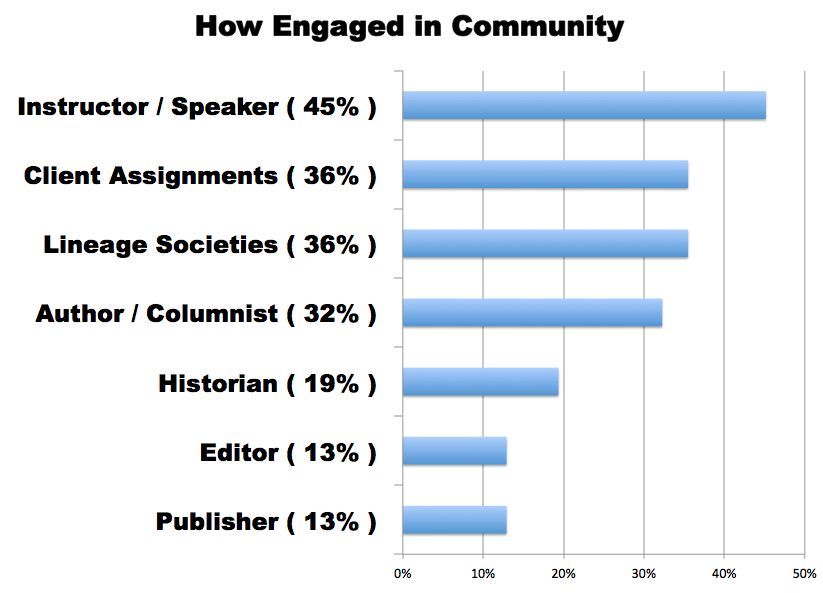Survey Results
Findings Relevant To Ancestral Lineages and Pedigrees
This 2011-12 survey was intentionally brief and focused, producing four principal findings from a representative group of both professional and non-professional genealogists and family historians. These findings cover
(1) openness to an alternative ancestral numbering system,
(2) benefits considered most important,
(3) importance of software available, and
(4) software programs used or recommended most often. These findings are first summarized below and followed by a review of survey participants’ relevant experiences.
Concerning work with ancestral lineages and pedigree numbering systems, the survey consisted of nine multiple-choice questions, and responses to all of these are summarized below. Voluntary access to the survey was open for two months through both the NEHGS online article and the Ancestral Lines website, as well as in response to invitations emailed to a list of qualified professionals and private genealogists.
Adopting a Numbering System:
- Approximately three-quarters – 78% – of survey participants overall indicated “Yes,” and 94% indicated “Yes” or “Maybe” in answer to the question, “Are you generally open to using a numbering system for ancestral Lines and Generations upon occasion, primarily as an alternative to an Ahnentafel, provided it is adequately documented and freely available?” Among participants who handled client assignments, two-thirds – 67% – indicated “Yes” to this question, and 87% indicated “Yes” or “Maybe.”

2A. The following benefits were considered the most important by participants in adopting another ancestral numbering system. Survey participants selected these benefits from a “randomly” ordered list of 18 plus write-in for each respondent.

2B. A significant positive comparison of Ancestral Lines to existing Ahnentafel-type systems was seen in survey results.

3. 65% of respondents answered “Important” or “Somewhat important,” with another 29% answering “Very important” or “Essential,” to the question, “How important would it be to you and your clients or audiences to have any new ancestral numbering system incorporated into one or more generally available genealogical software programs?”
4. The following genealogical or charting software programs were selected by participants as those most often used or recommend, especially for working with ancestral pedigrees or Ahnentafels: (a) Family Tree Maker (Ancestry.com), (b) RootsMagic, (c) Legacy Family Tree, (d) Personal Ancestral File (PAF), (e) The Master Genealogist, (f) Ancestry Family Tree (AFT), (g) Heritage Family Tree, (h) Brother’s Keeper. [Five percent or more of survey participants selected these programs from a “randomly” ordered list of 24 plus write-in for each respondent, although others also were selected.]
Participants’ Experience:
A. Participants’ averaged 22 years of experience “significantly engaged in family history or genealogy,” with 36% of respondents being in the range of 16-25 years. The full range of experience was from “fewer than five” (7%) to “more than 40” years (10%).
B. Nearly all survey participants reported they had engaged in their own lineage or family research over the past several years, with 36% having had client assignments. 45% had been instructors or speakers.

C. Just over one-half of the participants reported that 30 to 50 percent of their activities or engagements over the past several years had included working with some form of ancestral pedigree or Ahnentafel. Approximately one-quarter of respondents reported more than this amount of experience, and the remaining one-quarter reported less.
D. When working with ancestral pedigrees or lineages, approximately one-half of participants indicated that in 75% or more of projects, they or their clients or audiences used the term ancestral “LINE.”
E. Just over one-half of survey participants indicated that in 75% or more of projects, they or their clients or audiences used the term ancestral “GENERATION” when working with ancestral pedigrees or lineages.
Participants’ Comments:
Only a few participants added comments, and these were generally complimentary — so much so that to reproduce them here would probably appear unrepresentative. The following three were clear and concisely to their points:
“I like the idea. I like the simplicity and elegance.”
“Excellent. Visually clear, compatible with incomplete research, blended families, DNA, and the modern techniques. We need it!”
“I’m an Engineer who works with Military Specs for the DOD and this format is similar to how we write the specs. Its structure is easy to follow and makes sense. The system currently in Genealogy software makes no sense at all because you cannot look the assigned number in the middle of a pedigree and determine anything about that person. Thank you and please push the software companies to add this option to new versions of their software. I would upgrade my Legacy if this were available.”
Ancestral Lines Features and Benefits
The Ancestral Lines Pairing System was created to provide significant new benefits to both professional and non-professional family historians and genealogists. These have been described, with relevant examples, principally with the initial 2011 publication of the system.
There also have been a few occasions on which a more direct summary of these “features and benefits” has been called for. In response to those users and potential product developers (of software programs, printed charts and the like), the following organized list of “Top Features and Benefits” is provided.
AncestralLinesFEATURES&BENEFITS2011Dec18

As more user- and developer-generated features and benefits are evident, we plan to add them to this section of the Website. As you have your own “developments” to include, please let us know — we are learning and growing with the applications! Once again, please just email collaborator@ancestrallines.net
This website and all images it contains are being used for limited and noncommercial purposes, principally colleague and collaborator communications and shared learning.
